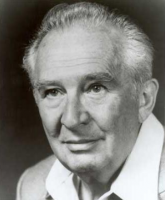










Jacob Rabinow was born in the Russian Ukraine as Yakov Aaronovich Rabinovichin 1910. The Russian Revolution forced his family out of Russia and into China, where his father died. In 1921 Rabinow, with his mother and brother, settled in Brooklyn, New York.
Education & Career
Rabinow received a B.S. in electrical engineering from the City College of New York in 1933, and in 1938 he began work as a mechanical engineer at the U.S. government Bureau of Standards. He left the Bureau of Standards in 1954 andstarted the to develop his reading machines. He sold the company to ControlData Corporation in 1964, staying on as the company's vice president from 1964 to 1972. In 1972 he returned to the government Bureau of Standards, where he is still employed.
A prolific inventor, Rabinow holds patents on over 200 inventions. He has, by his own estimate, thousands of unpatented "inventions in progress" filling ashelf full of notebooks in his Bethesda, Maryland home.
Rabinow began his career as an inventor during World War II while working forthe U.S. military, designing bomb and rocket fuses. His first patent for a camera designed to record airplane flight paths was granted in 1947 and was a direct result of his ordnance work.
Invention Career
Among Rabinow's most important inventions is the optical character recognition machine, the machine that reads numbers like those that appear on the bottom of bank checks and other documents. First developed in 1954 while working for the Bureau of Standards, Rabinow's sophisticated machines do not actually"read " the numbers but work more like the human eye. That is, they take strings of numbers even badly smudged or marred ones and compare them to a setof "best guess" samples. Variants of these optical scanners are widely used in business, industry and by the U.S. Postal Service. Rabinow's first readingmachine is on permanent display in the National Museum of American History, which is a component of the Smithsonian Institution.
Rabinow often invents things on a dare (such as his pick-proof lock or his self-justifying typewriter) or merely for the challenge (tired of constantly adjusting mechanical watches, he invented the self-regulating clock). He holdspatents in a wide range of technological areas: automated mail-handling equipment (sixteen patents); phonograph tone arms, turntables, and other audio equipment (eighteen patents); and various timekeeping mechanisms (seven patents). He has also patented roadway reflectors that lie flush with the road, a pressurized can to keep tennis balls bouncy, the first magnetic disk file for computers, an auto-focusing camera, a device to indicate whether the owner of atelephone has received a call in his absence, a camera tripod with legs thatcan be adjusted from a single point, and a sophisticated automatic automobile headlight dimmer. Rabinow's magnetic particle clutch is being used on someSubaru automobiles, on the drive mechanisms of some tape recorders, and to control the flaps in Learjets.
One of Rabinow's latest patents, issued in July 1986, is for a pick-proof lock. It is the result of nearly a half-century of pondering and tinkering withvarious models. Inspired by the remark of a lock company engineer who claimedit could not be done, Rabinow blended the mechanisms of both the combinationlock and a standard key mechanism to create his pick-proof model. Rabinow isquoted as having said: "A really good invention, in fact, is a work of art....A good invention has the same qualities as a good piece of poetry." Hehas also claimed that "inventions enrich both the natural wealth and the cultural life of a nation and the world....They are an art form and should be supported as such."
Rabinow has received numerous awards and honors, including a Certificate of Merit from President Truman in 1948 for his war-time efforts. In 1980 he was named Scientist of the Year by the editors ofIndustrial Research and Development magazine.